Seattle Mariners: Sodo Mojo’s 2019 Off-Season Plan

Today is the day. After weeks of prep, today is that day. The day where our staff’s hard work is finally realized and we unveil to the world our 2019 Seattle Mariners Off-Season Plan!
Now for those of you who are not familiar with the concept, basically our writers are asked to play Seattle Mariners GM and plan out an attack plan for this off-season. This means everything from trades, free agency, Rule 5 draft, and arbitration is all factors to deal with.
After each of our participating writers had an individual plan, we got together on our Discord (you can join by clicking here) and hashed out a plan for the entire site. After 8 hours of debate over the past 2 days, we are ready to unveil our plan.
But before we do, it is important to note that we had rules we needed to follow. First, there is the matter of money. For our operating budget, we set a cap at $175 million for the 40 man roster. The figure is roughly where the Mariners finished at the end of the 2017 season, and just a slight raise from where they finished in 2018.
For a reference point, the Mariners started with $132 million in guaranteed contracts before accounting for the 9 players who were arbitration eligible. The combined salaries of these 9 players left the team at $162 million already.
Thankfully, real life Mariners GM Jerry Dipoto did a lot of the heavy lifting there, waiving 6 players who were arbitration eligible, leaving only James Paxton, Alex Colome, and Mike Zunino due arbitration. All 3 players were extended arbitration offers from our panel, bringing the total starting payroll number in $150 million. So basically, we had $25 million to work with.
In addition to the payroll restrictions, the team was not allowed to trade Edwin Diaz, Mitch Haniger, or Marco Gonzales. At the time, we believed the Mariners wouldn’t be willing to truly rebuild so for simplicity, we took them off the table.
But of course, soon after wrapping up our plan, news broke that the Mariners are indeed willing to tear things down. After a brief debate, we decided that we would continue to bring you our original plan.
With all that in mind, we present to you, our 2018 Sodo Mojo’s Off-Season Plan!
FREE AGENT SIGNING: OF A.J. POLLOCK
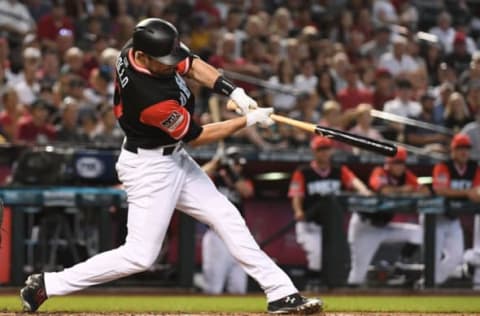
Contract details: Four years, $60 million
($12M/YR1, $15M/YR2, $15M, $18M/YR4)
Perhaps the biggest debate we had in our Discord was over what the Mariners should do in center field. We had numerous options brought forth, including for names like Keon Broxton and Joc Pederson.
At the end of the day, the debate fizzled down to Broxton vs A.J. Pollock. There was a lot of pro’s to both, but at the end, we felt better about Pollock’s track record than Broxton’s upside. The structure of the deal was also important to us, as we needed as much wiggle room with the payroll as possible.
We eventually settled on a structure that would pay Pollock $12 million in 2019, jumping to $15 million in 2020 and 2021, then finally at $18 million in 2022, after sizable contracts have come off the books.
Pollock would be the best CF bat for the Mariners since Mike Cameron, and he plays a solid defensive CF as well. The injury risk was weighed heavily, but ultimately, with the ability of Haniger, Dee Gordon, and Guillermo Heredia to cover CF for a short time, we decided that risk was worth taking.
Pollock’s career .467 slugging percentage will help replicate some of the right-handed power lost from losing Nelson Cruz, and his ability on the bases will be helpful as well. We all agree that Pollock isn’t the perfect answer in CF, but without any major prospects to go find one in the trade market, we decided to spend money on the position instead.
We have already written about Pollock at length on the site, which you can check out here. Long story short, Pollock’s blend of right-handed power with solid defense and base-running gave him the edge over Broxton.
However, we weren’t necessarily done with the Broxton debate.
FREE AGENT SIGNING: OF LONNIE CHISENHALL
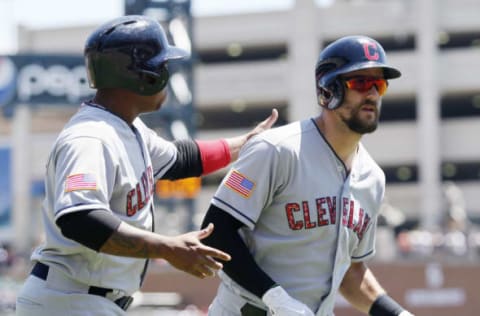
Contract details: One year, $4.5 million
The Mariners will miss Denard Span, but it’s possible they could find a very similar player on the open market this offseason. For us, that player is Lonnie Chisenhall, someone we’ve briefly talked about for Seattle in the past. Chisenhall has been one of Cleveland’s most consistently productive hitters over the years, but he just hasn’t been able to stay on the field for the majority of his career. At 30-years-old, he’s hitting free agency for the first time and the Mariners give him a great opportunity to bounce back in.
Chisenhall enters our plan as Seattle’s fourth outfielder, but where we really see him getting the most playing time is at designated hitter. With career splits that check out well against both right-handed and left-handed pitchers, Chisenhall gives the M’s another dynamic hitter they could utilize in multiple situations. While he doesn’t give you striking power numbers, Chisenhall can still run into one every now and then. He’s more of a gap-to-gap hitter, however, which is exactly what Span was for this team in 2018.
There’s an added level of flexibility in acquiring Chisenhall as well. In addition to playing both corner outfield spots, Chisenhall can play both third base and first base in a pinch. It should be noted, however, that he hasn’t played the hot corner since 2016, but we don’t see a reason why playing him there for a handful of games would be the end of the world. Seattle could also slot Ryon Healy, Kristopher Negrón, or Robinson Canó there if Kyle Seager needs an extended blow.
Health, of course, is the biggest factor in how productive Chisenhall truly could be in 2019. If he plays 120 or so games, he could end up being a bigger contributor than Span was. If not, the investment in him is so small that it doesn’t really matter in the end. Chisenhall is a really good player to take a flyer on. Depending on how you look at it, it’s a very low-risk, high-reward deal from Seattle’s end. It also gives Chisenhall a better opportunity to play fairly often, which is something most playoff contenders probably can’t offer him.
(Written by Ty Gonzalez)
TRADE: OF KEON BROXTON
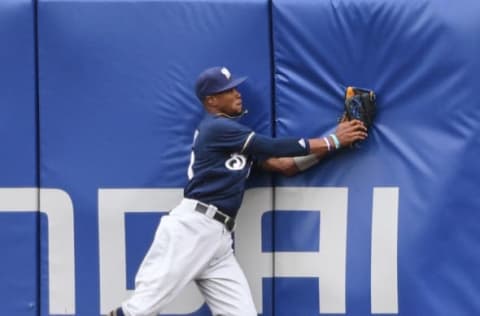
We’re choosing to not rely on Lonnie Chisenhall staying healthy for an entire season, but also give this team some much needed defensive depth in their outfield. You could say they already have that in Guillermo Heredia, but there is a little-to-no upside for him at the plate.
While Keon Broxton hasn’t performed at a consistent level with the bat, his combination of raw power and speed has gotten us excited about the prospects of him joining the Mariners. Not to mention he also has the potential to be one of the best defensive centerfielders in all of baseball, and perhaps even win a Gold Glove one day.
Broxton is certainly an exciting player, but he’s in a very similar situation to Daniel Vogelbach. Across the board, the Brewers may have the best outfield in the MLB, so there is no starting job available to Broxton.
They also have the likes of Domingo Santana and Tyrone Taylor on their 40-man roster, and top outfield prospects Corey Ray and Troy Stokes Jr. nearing their MLB debuts. Furthermore, Broxton is out of Minor League options, meaning that the Brewers will have to keep him on the 25-man roster for the entire 2019 season. That’s probably not going to happen.
From a talent standpoint, Broxton is worth more than James Pazos. But the circumstances surrounding his situation in Milwaukee likely mean Pazos is the best thing the Brewers could get for him. Losing Pazos is a tough pill to swallow for Seattle, but a necessary one given our acquisitions of lefty relievers in this plan. With Wade LeBlanc and Roenis Elías also in contention for bullpen jobs, the number of lefties on the 40-man roster was a bit overkill.
In essence, this is a deal of excess for excess. The Brewers aren’t necessarily strapped for bullpen pieces, but Pazos makes a great bullpen even better. With Pollock, Haniger, Chisenhall, and Gamel also in the fold, Broxton is more of a luxury for the M’s. However, Broxton will be given a chance to start and could find himself as the team’s centerfielder if he hits well, moving Pollock over to left field.
For us, our plan for Seattle’s 25-man roster is to disregard the traditional utility man and run with five outfielders. Given the positional flexibility of all four of Seattle’s starting infielders, and Chisenhall’s ability to play the corner spots, we think this is the best option for how we’ve constructed the roster.
(Written by Ty Gonzalez)
TRADE: 1B/OF JOSE MARTINEZ & RHP GIOVANNY GALLEGOS
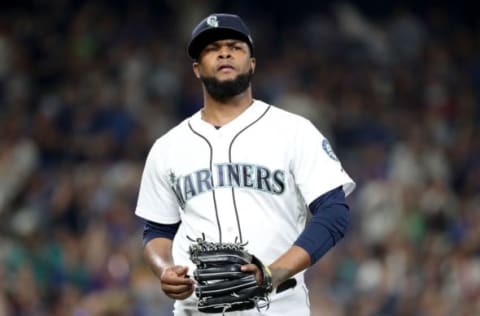
While A.J. Pollock was perhaps the most hotly contested part of our plan, trading Alex Colome was perhaps one of the easiest. It’s not because we don’t like Colome either. He is one of the better relievers in all of baseball. However, when you have many needs and not much money, relief pitchers set to earn $7 million are easy targets.
Colome is really good, and with 2 years of club control at a reasonable rate, Colome should have plenty of interest this off-season. Ultimately, there was near consensus that Cardinals first baseman and outfielder Jose Martinez was the perfect target for Jerry Dipoto.
You see, Martinez is a player built for the American League who is playing for the Cardinals. A truly horrific corner outfielder, Martinez was blocked at first base by Matt Carpenter. Martinez is strictly a 1B/DH type, but not one who posses the home run power traditionally associated with those positions.
What makes Martinez valuable is his insane bat. In his first 270 games, Martinez is a career .309/.372/.478 hitter. Those are near elite numbers. But with the Cardinals packed outfield, their desire to sign Josh Donaldson to play 3rd, and Matt Carpenter anchored at 1B, the Cardinals simply don’t have space for Martinez. They also happen to have a need for a back-end bullpen arm, which is where Alex Colome comes into play.
By acquiring Jose Martinez, the Mariners can let him play at 1B and DH without any concern for his defense. The move also nets them a decent bullpen depth piece in Giovanny Gallegos and saves the team about $6 million on their payroll.
But with Pazos and Colome gone, what is happening in the bullpen? Well, let’s head there next.
FREE AGENT SIGNING: LHP ANDREW MILLER

Contract details: Three years, $30 million
When constructing the Colomé deal, we knew there were plenty of options on the free agent market to fill the hole he would leave open, thus leading us to Miller. Let’s be real — Andrew Miller is better than Álex Colomé, and Seattle has desperately needed an impact left-handed arm out of their bullpen for a while. James Pazos has been a nice piece in the M’s bullpen for the most part, but can’t compare to the dominance Miller has had over the past seven seasons.
Miller did struggle with some injury concerns in his throwing shoulder in 2018, ultimately leading to a relatively subpar season by his standards. However, his numbers still read off at an above-average rate, including an 11.91 K/9 and a 3.51 FIP in 34 innings. The injury didn’t hinder his velocity much but did appear to alter the bite on some of his other options. An offseason worth of rehab should bring him back to full speed, though, and we expect Miller could find his way back to an All-Star level of production right behind Edwin Díaz.
What makes Miller so fascinating is his cost. Even with the down year, an argument can be made for being the best reliever in his free agent class. However, the general consensus in free agency predictions seems to be that Miller will likely get a $9 million AAV, a pretty low number for someone of Miller’s capabilities, though that could be dictated one way or another depending on how the market truly shakes out. We’ve added an extra $3 million guaranteed to his widely predicted contract, giving him a $10 million AAV over three years in the Pacific Northwest.
Miller will be entering his age 34 season this year, putting him at 36 by the end of this contract. It’s a risky move, investing this kind of money in a reliever that age, but it all comes down to belief. Specifically, a belief in his ability to remain a dominant factor for a contender moving forward. We clearly believe in Miller doing just that.
(Written by Ty Gonzalez)
TRADE: LHP PAUL FRY
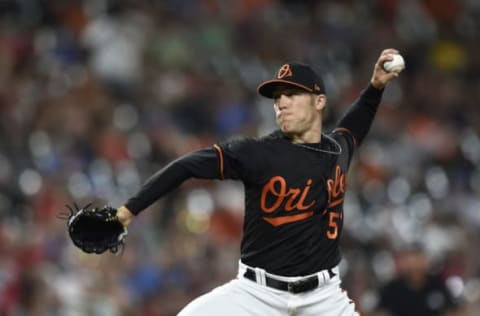
Look away fans of the large adult son. Yes, as difficult as it is to stomach (no pun intended), the Mariners simply have to move on from Daniel Vogelbach. They have almost religiously refused to give him regular PAs at the big league level, and now he is out of options. If he doesn’t make the club out of spring training (which is unlikely with Cano, Healy, and Martinez all ahead of him), he would need to clear waivers before being sent back down.
It is nearly impossible to fathom he clears. With very little leverage to make a trade happen and even fewer teams who make sense for Vogelbach, the return may seem a bit underwhelming. But truth be told, Paul Fry was really good for a bad Orioles team in 2018.
Fry posted a 3.11 FIP in 37.2 innings, striking out nearly a batter an inning in the process. In addition, Fry has been a groundball machine, posting an incredible 57.7% groundball rate in his MLB debut.
Although a left-handed reliever, Fry was actually better against RHH than LHH. He is an arm you can play matchup with, or give a full inning. Pairing Fry and Miller gives the Mariners a nice duo of left-handed relievers who induce groundballs.
Fry also has all 3 options remaining, and like Vogelbach, has 6 years of club control. The Orioles had some of the worst production in baseball out of the first base spot, and are in an obvious state of rebuilding. To land a potential DH and 6th inning reliever for Fry is likely the best the Orioles can hope for.
By now, I am sure you’re asking; “where is the starting pitching”? Well, we have finally arrived at our starting pitching addition.
FREE AGENT SIGNING: LHP YUSEI KIKUCHI
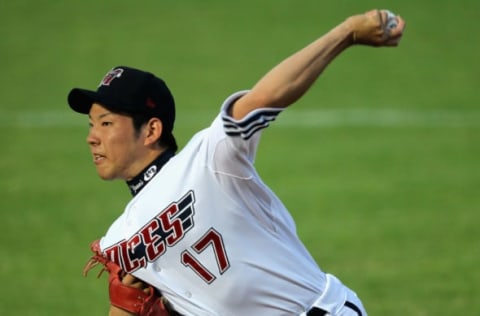
Contract details: Six years, $54 million
($4M/YR1, $6M/YR2, $8M/YR3, $10M/YR4, $12M/YR5, $14M/YR6)
Jerry Dipoto might be a bit hesitant to dip into the Japanese market once again after the Shohei Ohtani debacle, but there is another successful starting pitcher planning to come overseas and he fits perfectly with the route we’ve taken in our plan. The Seibu Lions have agreed to post 27-year-old southpaw Yusei Kikuchi, one year removed from a season in which he struck out 217 hitters in 187.2 innings pitched.
Now, Kikuchi isn’t a generational talent like Ohtani, but he’s been a highly productive starter in one of the world’s most competitive baseball leagues, the NPB. It’s also not very often that we’ve seen left-handed starters make their way overseas to the MLB. He’s unique and sits at a good age to produce at a high level rather quickly upon his arrival.
So while he may not be an Ohtani type, many have compared him to the likes of Kenta Maeda and Masahiro Tanaka — a solid pitcher with the ability to be dominant on occasion. He also comes pretty cheaply, though he’ll require the insurance of guaranteed years and dollars. We propose a plan to pay him $4 million in year one, with $2 million yearly increases for each of the next 5 seasons.
Still, compared to some of the deals projected to other starters on the open market, this is absolutely the perfect opportunity for a team in the financial position the Mariners currently find themselves in.
The deal comes with one caveat, however, as Kikuchi has dealt with some lingering issues in his left shoulder over the last two seasons. This may scare off some teams from giving him the type of deal we have Seattle offering, which should ultimately help the M’s in their pursuit of Kikuchi. It’s a risk worth taking for a middle-of-the-road team preparing for life without Félix Hernández and perhaps James Paxton.
TRADE: C LUKE MAILE
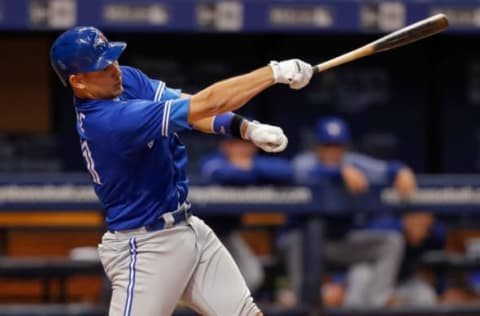
Our attention now turns to one of the more overlooked spots on Seattle’s roster: their backup catcher. For years now, the M’s have heavily relied on Mike Zunino figuring things out while never providing a true backup plan. The best catcher they’ve had in the Dipoto years was Chris Iannetta, though he was brought on to start. Outside of Iannetta, Seattle has acquired Carlos Ruiz, Steve Clevenger, David Freitas, Mike Marjama, Chris Herrmann, and Tuffy Gosewisch over the last three years, all offering little insurance to Zunino’s extremely low floor.
We have the Mariners rectifying that in our plan, snagging Blue Jays backup catcher Luke Maile for rising starting pitching prospect Darren McCaughan. Maile is just a career .219/.281/.337 hitter, but for some reason, he becomes one of the more consistent hitters on Toronto’s roster in 2018. Out of nowhere, Maile finished his season with a .248/.333/.366 slash over 66 games, making the most out of his opportunities in supplementing Russell Martin. The best tool Maile has to offer at the plate is his ability to get on base, something Zunino has failed to do for most of his career.
Maile’s been a strong defender his entire career, but his bat held him back from breaking his reputation as no more than a tertiary option at catcher. Now that he’s seemingly found success at the plate, Maile’s value has greatly increased and the Jays don’t really need him with Martin and top prospect Danny Jansen around.
Losing McCaughan is a tough blow to a farm system that features very few talented starters. But it’s a price we’re willing to pay to finally properly fill a spot that feels more necessary than it should be. Maile has shown the propensity to step into a starting role if Zunino were to go down or struggle at the plate once again, allowing Seattle to not feel as suffocated at the position as they’ve been in the past.
Maile is in the final pre-arbitration year of his contract, coming in at the very low cost of $558,400. For reference, Herrmann was projected to make about $1.5 million in arbitration before the M’s let him walk, meaning they save roughly $1 million of estimated dollars by going this route.
(Written by Ty Gonzalez)
THAT’S A WRAP
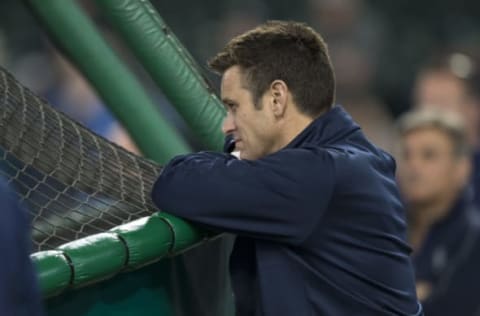
That will put a bow on our 2019 Off-Season plan. We will see if Jerry Dipoto and the team render it all moot with today’s announcement that they are willing to tear things down a bit in 2019. However, for the time being, let’s take a look at the depth chart:
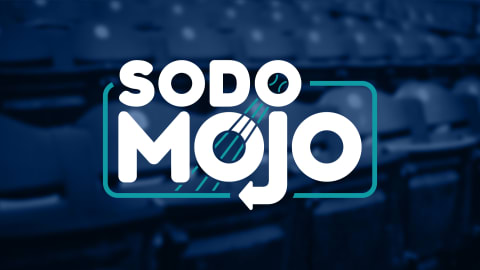
As you can see, our plan leaves the Mariners with a deep bullpen and a lot of flexibility. There were several things that were discussed but ultimately left out. Among them was trading Ryon Healy and Mike Leake. However, we couldn’t find a deal we loved for Healy, and since he had 3 options left to Vogelbach’s zero, we decided to stash Healy in AAA.
Trading Mike Leake would clear up roughly $10 million from the 2019 payroll. But since we came in on the budget, and the $10 million was likely going to go to a worse starting pitcher than Leake, we decided against it.
If you are wondering how the lineup would shake out, here are a few possibilities:
1. Segura, SS
2. Pollock, LF
3. Cano, 2B
4. Martinez, 1B
5. Haniger, RF
6. Chisenhall, DH
7. Seager, 3B
8. Zunino, C
9. Broxton, CF
Or against RHP:
1. Segura, SS
2. Pollock, CF
3. Cano, 1B
4. Martinez, DH
5. Haniger, RF
6. Seager, 3B
7. Gamel, LF
8. Zunino, C
9. Gordon, 2B
Overall, the lineup could definitely use some more pop. Hopefully, with Pollock getting most of the AB’s instead of Gordon in CF, and a full season of Robinson Cano will help out there. Overall, we are reasonably happy with how things turned out.
dark. Next. Mariners to Consider Tearing it All Down?
If you would like to see the full transcript of our 8 hours of discussion, you can click the link to join the discord (it’s free). Be sure to be on the lookout for our upcoming off-season simulation with the other sites in the FanSided family!
Until next guys, Go Mariners!